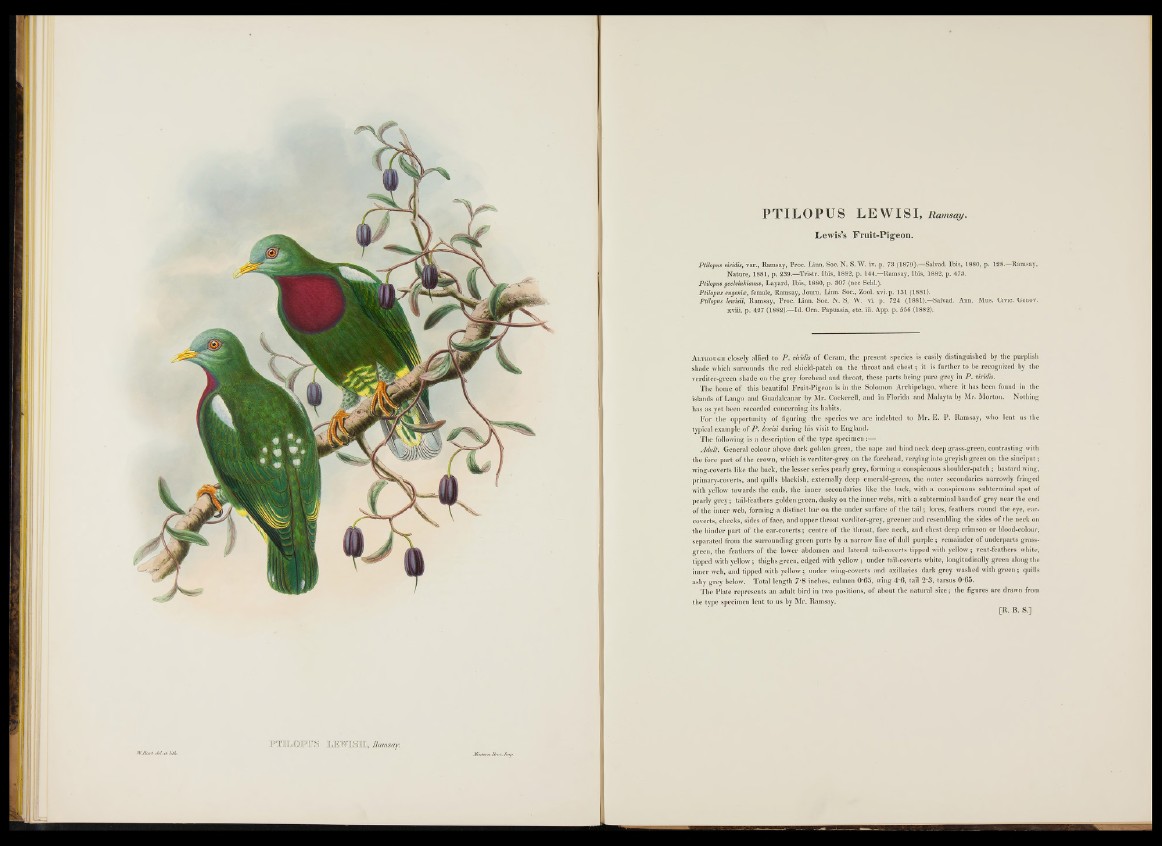
FTBLOPUS JLEWIS1 , Brnnsm.
PTILOPUS LEWISI, Ramsay.
Lewis’s Fruit-Pig'eon.
Ptilopus viridis, var., Ramsay, Proc. Linn. Soc. N. S. W. iv. p. 73 (1879).—Salvad. Ibis, 1880, p. 128.—Ramsay,
Nature, 1881, p. 239.—Tristr. Ibis, 1882, p. 144.—Ramsay, Ibis, 1882, p. 473.
Ptilopus geelvinkianus, Layard, Ibis, 1880, p. 307 (nec Schl.).
Ptilopus eugenics, female, Ramsay, Journ. Linn. Soc., Zool. xvi. p. 131 (1881).
Ptilopus lewisii, Ramsay, Proc. Linn. Soc. N. S. W. vi. p. 724 (1881).—Salvad. Ann. Mus. Civic. Genov,
xviii. p. 427 (1882).—Id. Orn. Papuasia, etc. iii. App. p. 556 (1882).
A l t h o u g h closely allied to P . viridis o f Ceram, the present species is easily distinguished by the purplish
shade which surrounds the red shield-patch on the throat and c h e s t; it is further to be recognized by the
verditer-green shade on the grey forehead and throat, these parts being pure grey in P. viridis.
The home o f this beautiful Fruit-Pigeon is in the Solomon Archipelago, where it has been found in the
islands o f Lango and Guadalcanar by Mr. Cockerell, and in Florida and Malayta by Mr. Morton. Nothing
has as yet been recorded concerning its habits.
F o r the opportunity o f figuring the species we are indebted to Mr. E. P. Ramsay, who lent us the
typical example of P. lewisi during his visit to England.
The following is a description o f the type specimen :—
Adult. General colour above dark golden green, the nape and hind neck deep grass-green, contrasting with
the fore p art of the crown, which is verditer-grey on the forehead, verging into greyish green on the sinciput;
wing-coverts like the back, the lesser series pearly grey, forming a conspicuous shoulder-patch; bastard wing,
primary-coverts, and quills blackish, externally deep emerald-green, the outer secondaries narrowly fringed
with yellow towards the ends, the inner secondaries like the back, with a conspicuous subterminal spot of
pearly g r e y ; tail-feathers golden green, dusky on the inner webs, with a subterminal band o f grey near the end
of the inner web, forming a ’distinct bar on the under surface of the t a il; lores, feathers round the eye, ear-
coverts, cheeks, sides o f face, and upper throat verditer-grey, greener and resembling the sides o f the neck on
the hinder p a rt o f the ear-coverts; centre o f the throat, fore neck, and chest deep crimson o r blood-colour,
separated from the surrounding green parts by a narrow line o f dull purple ; remainder o f underparts grass-
green, the feathers o f the lower abdomen and lateral tail-coverts tipped with yellow; vent-feathers white,
tipped with yellow ; thighs green, edged with yellow ; under tail-coverts white, longitudinally green along the
inner web, and tipped with yellowy under wing-coverts and axillaries dark grey washed with g reen ; quills
ashy grey below. Total length 7*8 inches, cnlmen 0 6 5 , wing 4*6, tail 2*3, tarsus 0*65.
The Plate represents an adult bird in two positions, o f about the natural siz e ; the figures are drawn from
the type specimen lent to us by Mr. Ramsay.
[R. B. S.]